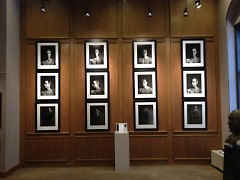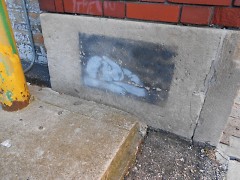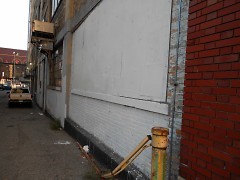Now that the Top Ten has been announced, it’s time to not only check out the entries in the running for the $200,000 cash prize, but also the venues whose work may give you pause for thought and leave you thinking long after you leave.
Part of ArtPrize's mission is to “promote critical dialogue and collaboration” and one of the year’s best examples of the actualization of this goal is Fountain Street Church. The venue has a clear purpose: addressing issues of social justice, which ranged from human trafficking to Hurricane Katrina, and the church worked in collaboration with the ACLU to showcase a variety of conversation-starting work.
ArtPrize juror Tom Eccles, Director of Curatorial Studies at Bard College, selected Fountain Street Church as one of his five picks for Outstanding Venue. Two of the photography entries also earned early recognition by ArtPrize jurors, being placed on Modern Painters columnist Tyler Green’s short list of 2-D work.
“Identity Process: Kings & Queens” a series by West Michigan-based Lora Robertson was described by Green as “a clear, sensitive narrative about gender identity and how we all play a role in presenting our genders and what our identity is.” He also selected Kendall student Robert Andy Coombs’ “Disabilities and Sexuality,” as a beautiful example of the type of art that “for years has focused on giving us a fuller idea of who our fellow man is.”
Though the works received nods from Green, they have received mixed reviews and misguided reactions from the public. During Green’s Short List announcement, the issue of each of the works being “provocative” given their sexual content was raised by WoodTV8 Daybreak anchor and co-host of the station’s broadcast of the short list Brett Thomas.
Green was quick to point out that Robertson’s piece addressed identity more than sexuality, and regarding Coombs’ work he replied, “It’s not very provocative. It’s almost tender. Its approach encourages us to think of people more fully.”
Additionally, Fountain St. Church was one of two venues listed on local Mommy blog GRKids.com as “Exhibits Kids Might Want to Miss.” The other venue was Frederik Meijer Gardens for its exhibits that depict male and female nudes.
Whether a work is appropriate for a child is, of course, ultimately the decision of the parent/guardian; however, it’s unfortunate that this important venue may be missed, and in turn, the opportunities for parents to use art as a catalyst to share and discuss important ideas with their children may be missed as well.
Missing Fountain Street Church also prevents the chance to view contemporary work in a setting that is rich in its own traditional pieces, including the Roman architecture and examples of Byzantine art. Near the entrance to the sanctuary, the mosaic and gold-leaf domed ceiling portraying four guardian angels symbolizing Justice, Liberty, Peace, and Fraternity, is one of the most beautiful works in the city, a must-see any day of the year.
Leaving Fountain Street Church, I was moved by the works I encountered. I was also reminded of the beauty found in places all over Grand Rapids and the unfortunate ability for it become forgotten or worse, avoided or covered up.
Like most powerful collisions with art, the experience caused me to open my eyes a little wider to the spaces around me. As I walked past the alley next to the church, I noticed a small stencil of a sleeping child on a concrete wall. The small portrait made me smile, made me stop, its nearly-hidden existence like some sort of treasure I’d been lucky enough to find.
As I looked up from the stencil, I noticed something more apparent. It was a large space – a space often used as canvas by street artists and one of my favorite pieces of concrete in the city – painted over in white; blank with nothing to say.
The Rapidian, a program of the 501(c)3 nonprofit Community Media Center, relies on the community’s support to help cover the cost of training reporters and publishing content.
We need your help.
If each of our readers and content creators who values this community platform help support its creation and maintenance, The Rapidian can continue to educate and facilitate a conversation around issues for years to come.
Please support The Rapidian and make a contribution today.



Comments
I agree, I thought the last two paragraphs were really great.